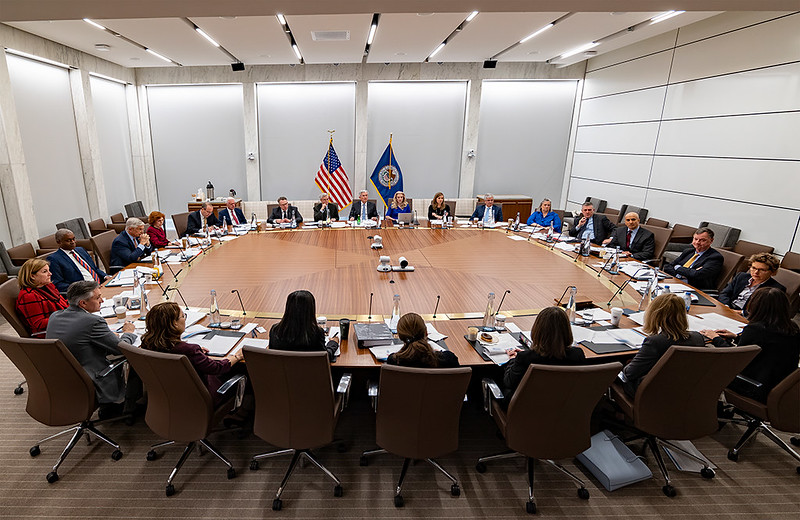The Federal Reserve (FED) is on the cusp of its biggest measure yet to combat soaring inflation with a massive increase in interest rates.
Policy makers began a two-day meeting yesterday and are widely expected to raise interest rates by half a percentage point – the largest rate increase in more than two decades. In March, they raised the interest rate by 0.25 percent for the first time since 2018.
These will be followed by other expected increases, up to a total of six, starting from this May and the beginning of the first quarter of 2023. Thus, the final rate – the highest ceiling in the federal funds rate during this period of tightening – is 4 percent. The Federal Reserve is expected to maintain this ratio in 2023 before starting to reduce it to return at the end of the year 2024 to its normal rate, which is estimated to be around 2.5 percent.
Recession on its way
It is natural that this strict policy will lead to economic stagnation, but what matters to the FED is to curb inflation. This is what former FED Vice Chairman Roger Ferguson told CNBC ahead of the Federal Reserve’s Federal Open Market Committee meeting, saying: “A recession at this point is unfortunately almost inevitable.” He expects the recession to continue into 2023, and he hopes it will be ‘soft’.”
A Bloomberg Agency poll also showed that 27.5 percent of economists surveyed expect a recession in the US.
Many economists consider that the “FED” was too late in its plan to curb inflation, and that it eased the issue of its growth when it was considered “temporary.”
Some analysts question the ability of the US central bank to achieve this delicate balance between containing inflation and preventing stagnation, after it waited until inflation rose to this extent. They warn that the kind of hard work that is needed now to control prices is likely to lead to economic deflation. Deutsche Bank last week predicted a “great recession” next year.
An economic recession is a negative growth in the GDP of any country during two consecutive quarters, that is, for a period of more than six months.
The US economy contracted at an annual pace of 1.4 percent in the first quarter of 2022. The IMF reduced its forecast for the growth of the US economy to 3.7 percent in 2022, down 0.3 percent since its last forecast.
Inflation keeps rising
The increase expected to be announced on Wednesday can be seen as a clear sign of the urgency with which the Federal Reserve is approaching inflation, as prices continue to rise at the fastest pace in 40 years.
Inflation accelerated further in March, reaching its highest level since December 1981. American consumer prices rose 8.5 percent in the twelve months to March.
The Fed certainly won’t stand here. It is very likely that it will continue to push up borrowing costs in the coming months.
Here’s a quick look at the Fed’s battle plan.
Why is the Federal Reserve raising interest rates?
Because it worries that prices will continue to rise too quickly as people continue to spend money. Demand is also so strong that it is beyond what companies can deliver, given that global supply chains remain fragile and employers still struggle to find enough workers.
A key gauge from the US Commerce Department last week showed prices rose 6.6 percent in the twelve months to March. That’s more than three times the federal inflation target and the largest price increase since 1982.
The FED hopes to curb demand and ease inflation by making it more expensive to borrow money.
How far will the Federal Reserve raise interest rates?
Experts say interest rates may have to rise significantly to reduce demand after the FED kept borrowing costs at rock bottom during the coronavirus pandemic.
On average, FED policymakers said at their March meeting that rates would need to rise by nearly two full percentage points this year, with additional rate increases next year.
Federal Reserve Chairman Jerome Powell said the central bank will closely monitor the performance of the economy and adjust the pace of rate hikes as needed.
But Powell believes that the Fed’s usual practice of raising interest rates a quarter point at a time may not be enough. He points out that the central bank needs to move aggressively up front and then reassess as needed.
“It is appropriate in my view to move a little faster,” Powell said at an IMF forum last month.
How will increased borrowing costs affect the economy?
Higher interest rates make getting a car loan or carrying a balance on a credit card more expensive.
It also raises the cost of buying a home. Mortgage rates have already risen above 5 percent in anticipation of the FED actions, up from less than 3 percent a year ago. This adds, for example, about $370 to the monthly payment for a median home.
The Fed’s intention is to raise interest rates with the goal of discouraging spending enough to reduce inflation, without pushing the economy into a recession – what economists call a “soft landing.”
“That’s our goal,” Powell said. “I don’t think you’re going to hear anyone at the FED say it’s going to be straightforward or easy.”
What other steps is the Federal Reserve taking?
In addition to raising interest rates, the Fed is expected to announce plans to gradually reduce the collection of government bonds and mortgage-backed securities it has bought during the pandemic.
Buying these bonds helped inject money into the economy and keep borrowing costs low. Thus, reducing the Fed’s holdings should have the opposite effect, i.e. curbing demand and helping to curb inflation.








